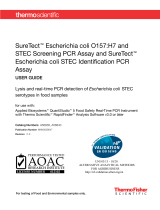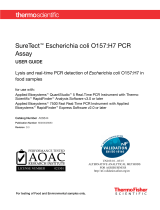Page is loading ...

Peptone Preview Pak
Catalog Number 215379
Doc. Part No. GRA0011237 Pub. No. MAN0019105 Rev. B.0
WARNING! Read the Safety Data Sheets (SDSs) and follow the handling instructions. Wear appropriate protective eyewear,
clothing, and gloves. Safety Data Sheets (SDSs) are available from thermofisher.com/support.
Product description
Gibco™ Peptone Preview Pak is not manufactured under GMP conditions and is for evaluation use only. When initially using Peptone
Preview Pak, it is recommended that each peptone be concurrently evaluated to determine the peptone(s) which are most optimal to your
culture system.
Gibco™ peptones are recommended for use with mammalian or microbial cell cultures, as supplements and/or feeds, to enhance growth,
protein production, and overall culture performance in batch or fed-batch processes.
Contents and storage
Table 1 Peptone Preview Pak, Cat. No. 215379
Contents Amount Storage
Wheat 100 UF 100 g
2°C to 25°C. Store in a dry place. Protect from heat,
sunlight, and wide temperature swings.
Cotton 100 UF 100 g
Cotton 200 UF 100 g
Soy 100 100 g
Yeast 100 100 g
Procedural guidelines
• Peptone powders are hygroscopic and should be stored at 2–25 °C in a dry place away from heat, sunlight, and wide temperature
swings.
• When the peptone powder bottle has been opened for initial use, it should be tightly closed as soon as possible to protect the
powder from absorbing moisture.
• Do not use if the bottle or powder shows evidence of damage, microbial contamination, or other signs of deterioration, such as
powder caking or discoloration.
• Store reconstituted, sterilized peptone stock solutions at 2–8 °C in a tightly sealed container and protected from light.
• Do not use liquid stock solutions of peptones if they show evidence of precipitation or other signs of deterioration.
• Refer to the product label for the expiration date of each powder supplement when stored properly.
• Prepare peptones in M9 Minimal Salts (2x), or in an equivalent solution.
• Further supplementation with carbohydrates, growth factors, mineral salts or any other microbial specific supplements can be added
as required.
USER GUIDE
For Research Use Only. Not for use in diagnostic procedures.

Mammalian cell culture application
Reconstitute peptones
Reconstitute the peptone powders to 100 g/L using the following instructions:
1. Weigh 10 g of peptone powder.
2. Fill a clean 250 mL flask with approximately 90 mL room temperature water for injection (WFI) or equivalent.
3. Add the peptone to the flask and mix until completely dissolved.
4. Once completely dissolved, bring volume to 100 mL with WFI or equivalent.
5. Sterilize the solution by filtering through a 0.2 μm filter membrane or by autoclaving.
6. Store solution at 2–8 °C.
Titration study–batch culture in shake flask
1. Prepare shake flasks by adding an appropriate volume of reconstituted peptone (100 g/L stock solution) and basal medium to the
final concentrations shown in Table 2.
Table 2 Titration study experimental set up (mammalian cell culture)
Condition Peptone concentration Base medium Peptone stock Total volume
Concentration 1 1 g/L 49.5 mL 0.5 mL 50.0 mL
Concentration 2 3 g/L 48.5 mL 1.5 mL 50.0 mL
Concentration 3 6 g/L 47.0 mL 3.0 mL 50.0 mL
Concentration 4 9 g/L 45.5 mL 4.5 mL 50.0 mL
Base medium only (negative
control) — 50.0 mL — 50.0 mL
Note: This table provides guidance for titration of one peptone; similar set ups can be used for all peptones. Add appropriate
positive control if needed.
2. Prepare seeding cell culture according to standard protocols. If cells are being cultured in a peptone containing medium, wash cells
once in sterile PBS and pellet by centrifugation. Prepare seeding cell suspension by re-suspending the cell pellet in either PBS or the
base control medium (negative control medium).
3. Inoculate shake flasks with standard seeding density.
4. On days 0, 3, 5, 7, 10, and last day of cell culture, determine viable cell density and percent viability.
5. Adjust glucose and L-glutamine levels as appropriate for the base medium throughout the experiment.
6. Determine protein titer on various days of culture, including the last day, to determine cumulative protein production.
2Peptone Preview Pak User Guide

Mixture study–batch culture in shake flasks
The peptones can also be blended to determine if additional enhancement is possible. Table 3 provides instructions for the experimental
set up using 100 g/L stock solutions. It is suggested each peptone in the pack is blended in a 1:1 ratio with the Yeast 100 for a total
peptone concentration of 3 g/L. Additional blending strategies should be evaluated based upon the results from the titration studies or
from the suggested blending study.
Table 3 Mixture study (mammalian cell culture)
Mixture Yeast 100 Cotton 100 UF Cotton 200 UF Soy 100 Wheat 100 UF Base medium
volume
Mixture 1 1.5 mL 1.5 mL — — — 47 mL
Mixture 2 1.5 mL — 1.5 mL — — 47 mL
Mixture 3 1.5 mL — — 1.5 mL — 47 mL
Mixture 4 1.5 mL — — — 1.5 mL 47 mL
Base medium only
(negative control) — — — — — 50 mL
Peptone Preview Pak User Guide 3

Microbial cell culture application
Reconstitution instructions
It is recommended the peptone powders be hydrated at 30 g/L using the following instructions:
1. Weigh 6 g of the peptone powder.
2. Fill a clean 500 mL flask with approximately 180 mL of room temperature prepared M9 Minimal Salts solution or equivalent.
3. Add the peptone to the flask and mix until completely dissolved.
4. Measure pH at room temperature and adjust to the optimum pH for the application. A typical pH can range from 6.5 to 7.54
depending upon the microorganism. Avoid excessive pH adjustments.
5. Once completely dissolved, bring the final volume to 200 mL with room temperature prepared M9 Minimal Salts solution or
equivalent.
6. Sterilize the solution by autoclaving or filtering through a 0.2‑μm filter membrane.
7. Store solution at 2–8 °C.
Titration study in shake tubes or flasks
A peptone screen should be designed so that each peptone is evaluated at a variety of concentrations. Typical working concentrations for
peptones range from 5 g/L to 30 g/L and are dependent on the microorganism’s requirements. Table 4 outlines a recommended peptone
titration experimental study starting with a peptone stock of 30 g/L in buered salt solution (M9 Minimal Salts or equivalent).
Table 4 Titration study set up (microbial culture)
Concentration Peptone
concentration Buered salt solution Peptone stock Total volume
Concentration–1 30 g/L — 50.0 mL 50 mL
Concentration–2 20 g/L 16.7 mL 33.3 mL 50 mL
Concentration–3 10 g/L 33.3 mL 16.7 mL 50 mL
Concentration–4 5 g/L 41.7 mL 8.3 mL 50 mL
4Peptone Preview Pak User Guide

Mixture study in shake tubes or flasks
Blends of peptones should also be considered, because synergistic eects have been observed in some processes when multiple
peptones are used. The top two performing peptones from the titration study can be blended with Yeast 100 as outlined in Table 5 and
Table 6 starting with a stock concentration of 30 g/L in buered salt solution (M9 Minimal Salts or equivalent).
Table 5 Mixture study (microbial culture)
Mixture Peptone 1[1] Yeast 100 Total concentration
Mixture 1 15 g/mL 15 g/L 30 g/L
Mixture 2 12 g/mL 8 g/L 20 g/L
Mixture 3 10 g/mL 10 g/L 20 g/L
Mixture 4 8 g/mL 12 g/L 20 g/L
Mixture 5 5 g/mL 5 g/L 10 g/L
[1] The same blend strategy should be competed with each of the peptones in the pack.
Table 6 Mixture experimental set up (microbial culture)
Test condition Peptone 1 stock Yeast 100 Buered salts solutions Total volume
Mixture 1 25.0 mL 25.0 mL — 50.0 mL
Mixture 2 20.0 mL 13.3 mL 16.7 mL 50.0 mL
Mixture 3 16.7 mL 16.7 mL 16.6 mL 50.0 mL
Mixture 4 13.3 mL 20.0 mL 16.7 mL 50.0 mL
Mixture 5 8.3 mL 8.3 mL 33.4 mL 50.0 mL
Related products
Unless otherwise indicated, all materials are available through thermofisher.com. "MLS" indicates that the material is available from
fisherscientific.com or another major laboratory supplier.
Item Source
Wheat 100 UF 215380
Cotton 100 UF 215381
Cotton 200 UF 215382
Soy 100 215383
Yeast 100 215384
Glucose, powder (1 kg) 15023021
Glucose Solution (50 mL) A2494001
L‑Glutamine (100 g) 21051024
Pluronic™ F-68 (Kolliphor™ P 188) (100 mL) 24040032
M9 Minimal Salts (2x) A1374401
Cell line specific supplements as required MLS
Limited product warranty
Life Technologies Corporation and/or its aliate(s) warrant their products as set forth in the Life Technologies' General Terms and
Conditions of Sale at www.thermofisher.com/us/en/home/global/terms-and-conditions.html. If you have any questions, please
contact Life Technologies at www.thermofisher.com/support.
Peptone Preview Pak User Guide 5

Life Technologies Corporation | 101 Schilling Road, Suite 20 | Hunt Valley, MD 21031
For descriptions of symbols on product labels or product documents, go to thermofisher.com/symbols-definition.
The information in this guide is subject to change without notice.
DISCLAIMER: TO THE EXTENT ALLOWED BY LAW, THERMO FISHER SCIENTIFIC INC. AND/OR ITS AFFILIATE(S) WILL NOT BE LIABLE FOR SPECIAL, INCIDENTAL, INDIRECT,
PUNITIVE, MULTIPLE, OR CONSEQUENTIAL DAMAGES IN CONNECTION WITH OR ARISING FROM THIS DOCUMENT, INCLUDING YOUR USE OF IT.
Important Licensing Information: These products may be covered by one or more Limited Use Label Licenses. By use of these products, you accept the terms and conditions of all
applicable Limited Use Label Licenses.
©2020 Thermo Fisher Scientific Inc. All rights reserved. All trademarks are the property of Thermo Fisher Scientific and its subsidiaries unless otherwise specified.
thermofisher.com/support | thermofisher.com/askaquestion
thermofisher.com
30 September 2020
/









